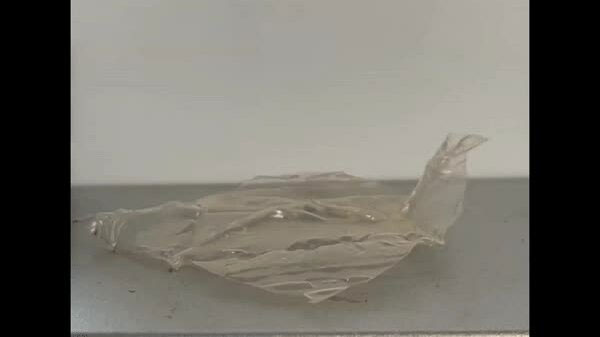Japanese experts have developed a new type of plastic with self-healing properties that remains durable at room temperature but is easy to degrade when no longer in use.
A team of scientists at the University of Tokyo has created a new eco-friendly plastic material that can be easily decomposed in recycling facilities or in nature, according to a report by New Atlas on November 6. This material is derived from epoxy resin vitrimer, which is stable at room temperature but can be reshaped when heated. While vitrimers are usually quite brittle, the research team improved the formula by adding polyrotaxane molecules.

When heated, VPR plastic returns to its original shape, in this case a crane. (Photo: Shota Ando)
As a result, they have created a new plastic known as VPR, which has numerous advantages over similar materials. If scratched with a knife, VPR can self-heal when heated to 150 degrees Celsius in just 60 seconds. Furthermore, if folded into the shape of a crane and then flattened, it can return to the crane shape when reheated. This new material performs all of these actions much faster than comparable materials.
When no longer in use, VPR is also easier to decompose. The combination of heat and a special solvent breaks molecular bonds, leaving only raw components that are ready to be remade into something new. Even when discarded in the environment, VPR is less harmful than other types of plastics. The research team demonstrated this by soaking the new material in seawater for 30 days. During this time, it biodegraded by 25% and released molecules that could serve as food for marine organisms.
“VPR has a fracture resistance that is five times greater than that of conventional epoxy resin vitrimer. The new material can also self-heal 15 times faster, restore its original shape twice as quickly, and be chemically recycled 10 times faster. It even biodegrades safely in marine environments, which is a new feature for this type of material,” stated Shota Ando, the lead author of the study. The new research was published in the journal ACS Materials Letters.
The scientists noted that VPR can be used for various applications that typically employ other types of plastics. “Some examples include materials for building roads and bridges, which often consist of epoxy mixed with composites like concrete and carbon. Using VPR, these structures would be easier to maintain because they would be more durable and could heal with heat. Unlike traditional epoxy, the new material is hard yet elastic, making it suitable for bonding materials with different stiffness and elongation properties. This could be essential for vehicle manufacturing,” Ando added.


















































